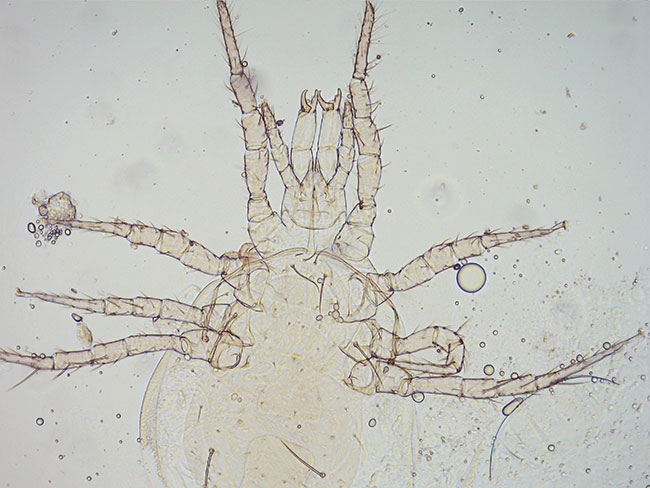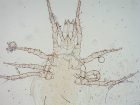
Features
Biocontrols
Inputs
Making the most of your predatory mites
Particular species need to be handled, stored and applied differently to optimize efficacy.
September 24, 2019 By Dr. Abida Nasreen
 Photo: GrowLiv Ltd.
Photo: GrowLiv Ltd.Mites don’t have the best reputation when it comes to the general public but growers pay thousands of dollars every year to get them into their greenhouses. In fact, most of the greenhouse crops grown in Canada are produced with the help of these very small organisms.
Mites are animals of the order Acarina and can be either pests or predators in the greenhouse. There are several varieties of predatory mites, each with their own preferred food sources. Life cycles are similar to many insect pests, starting with the egg stage, the larval period, the nymph stages and finally the adult. All life stages are predatory, except for the egg stage.
These tiny bugs might be small but they are voracious. They eat a variety of plant-consuming mites and insects. In the absence of prey, predatory mites are able to sustain their populations by eating pollen or nectar, which makes them great as a preventative measure on crops. Predatory mites were one of the first beneficial insects to be commercially produced for the greenhouse industry. They have attracted a lot of attention due to their role in the biological control of small arthropods. Pesticide resistance in many insect pests have further boosted their importance in crop pest management, and growers are turning to predatory mites as permanent solutions.
Specialists vs generalists
Commercially available predatory mites can be categorized as specialist or generalist predators. Specialist predators are used for targeting specific pests in the greenhouse, while generalists are used as a preventative method against a variety of different pests. Different species of mites prefer different environments in order to work optimally. For example, some work best on smooth leaf surfaces while others are better on hairier plants. Obviously, one mite will not fit in all situations, and having a good understanding of different types of mites and their behaviours is important to establishing a successful IPM program.
Generalist predatory mites are more effective when pest populations are low and more dispersed. Phytoseiid and Laelapid mites fall into this category of generalist predatory mites. Phytoseiids like to stay on plant surfaces, while Laelapids prefer to stay in the soil. Commonly used Phytoseiid mites are Neoseiulus californicus, Neoseiulus cucumeris, and Amblyseius swirskii. For Laelapids, commonly used species include Hypoaspis aculeifer and Hypoaspis miles (Stratiolaelaps scimitus). When applied augmentatively, these predatory mites commonly stay and breed in good numbers because they utilize a variety of food sources, feeding on pollen, fungal spores, and plant exudates. Some are able to feed, develop, and reproduce on these plant materials as well. However, Phytoseiids have mostly been used to control pests like spider mites and thrips, while Laelapids are used to control fungus gnat larvae, thrips pupae, springtails, strawberry root weevils, cactus root weevils and other soil-dwelling pests.
Specialist predatory mites work best as a curative method when pest infestation is just beginning. They should not be used as a preventative measure because specialist mites need specific prey to feed on or else they will starve and die, wasting money and time. A commonly used specialist mite is Phytoseiulus persimilis, which can only feed on two-spotted spider mites (TSSM, Tetranychus urticae). Specialist predatory mites generally reproduce faster, have better search abilities and can lower the pest prey population more quickly. Greater plant density, kairomones (chemicals emitted by the mite-infested plants) and webbing of TSSM all enhance the predacious ability of P. persimilis. One thing to note is that this predatory mite cannot be shipped with any food sources since it only feeds on two-spotted spider mite, thus it will starve if stored for too long. P. persimilis should be put out on the crops as soon as it is received to optimize its performance.
Handle with care
Proper care and handling are critical for predatory mites. If not handled properly, it is very easy to kill most of them in a short amount of time. It’s best to distribute mites the moment you receive them, but if you must store them, they should stay in a high-humidity environment (60 to 80% RH), in 25 to 27°C temperatures and with the boxes open to allow for ventilation. These are living, breathing things after all. Never keep them in your office if you don’t know the humidity levels there. Mites can tolerate changes in temperature, but will deteriorate quickly if the relative humidity is lower than 60%, especially if mites are packed in plastic bottles and slow release sachets. Papercraft tubes work a bit better at lower humidity levels. If the mite is P. persimilis, keep them at high RH levels of 60 to 80% and low temperatures of 17 to 14°C, These conditions will keep them sluggish until they are released.
How to apply predatory mites
Application of predatory mites is an important step to getting consistently high populations. There are three common ways to release these predators onto the crop.
The first is the sprinkling method. Predatory mites are packed with a medium (usually vermiculite, bran, or woodchips) in a plastic or a papercraft tube and are sprinkled on the crop with a dispenser. Mites will be dispensed by greenhouse workers while walking through the rows or passing by the growing benches.
The second method is by slow-release sachets, which are water-resistant paper bags sealed from all sides, creating the perfect environment for mites to breed and dispense overtime into the crops. Sachets work very well as a preventative measure since they can maintain a population of mites for a long period of time. However, the placement of the sachet is very important – it can reduce the life span of the sachet from six weeks to maximum one or two weeks. This is a huge waste of money. When placing the sachets on your crop, avoid places that are hit by direct sunlight, are highly ventilated, or have low humidity. It is also very important that the sachet touches the plant so that the mites being dispensed are on the plant right away. When using sachets, do not poke another hole to dispense the mites faster, as this will ruin the microenvironment inside the sachet.
The third is the broadcasting method. In some situations, people prefer to use modified leaf blowers to spread predatory mites, and Amblyseius species in particular. This method is mostly used when the application of sachets or sprinkling do not seem cost-effective. Mites are mixed with a vermiculite carrier when broadcasted, as the vermiculite makes for greater ease of application and consistency compared to bran. However, note that broadcasting may hamper proper distribution, leaving a good number of mites on the ground. Quality is also affected due to high air pressure. Proper monitoring of the number and survival of mites on the plants is necessary.
P. persimilis is not available in sachet form because it feeds only on TSSM and not bran mites. Therefore, it can only be applied by sprinkling or broadcasting.
Abida Nasreen, PhD, is director of research and development at GrowLiv Ltd., www.growliv.com.
Print this page



